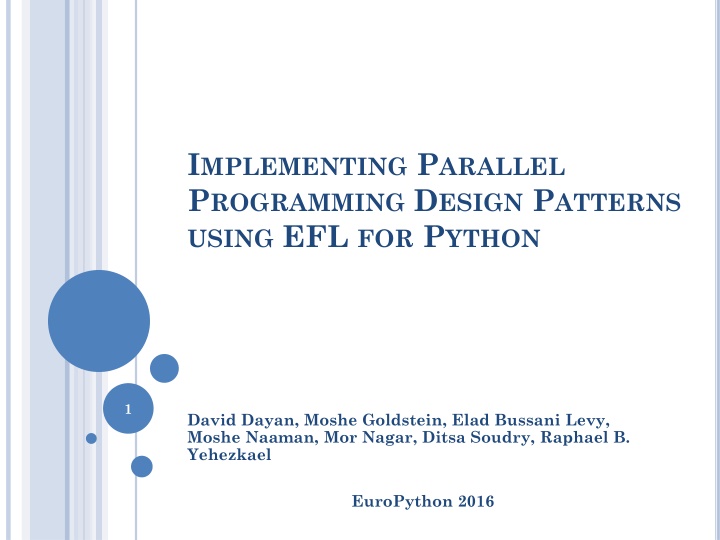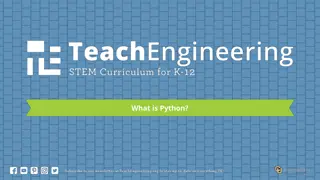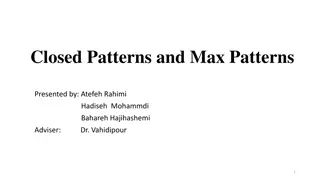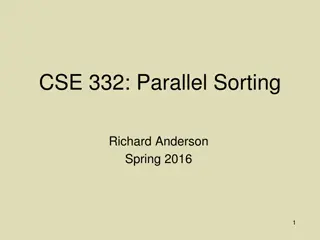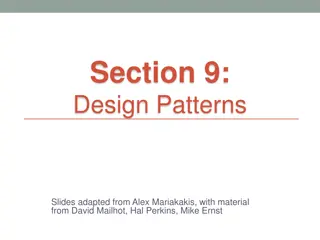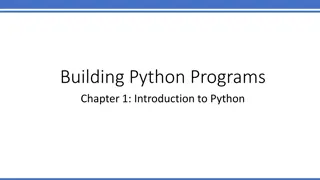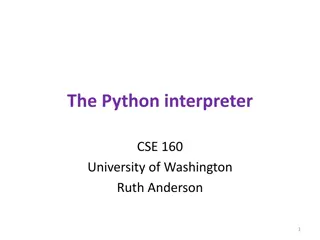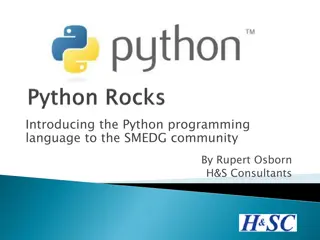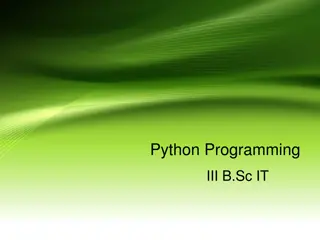Implementing Parallel Programming Design Patterns Using EFL for Python
This presentation explores the motivation and objectives behind developing a common parallel programming approach, introducing the Embedded Flexible Language (EFL) for Python. The EFL programming model allows for a straightforward implementation of sequential and parallel executions to produce deterministic results, freeing programmers from platform intricacies.
Download Presentation

Please find below an Image/Link to download the presentation.
The content on the website is provided AS IS for your information and personal use only. It may not be sold, licensed, or shared on other websites without obtaining consent from the author.If you encounter any issues during the download, it is possible that the publisher has removed the file from their server.
You are allowed to download the files provided on this website for personal or commercial use, subject to the condition that they are used lawfully. All files are the property of their respective owners.
The content on the website is provided AS IS for your information and personal use only. It may not be sold, licensed, or shared on other websites without obtaining consent from the author.
E N D
Presentation Transcript
IMPLEMENTING PARALLEL PROGRAMMING DESIGN PATTERNS USING EFL FOR PYTHON 1 David Dayan, Moshe Goldstein, Elad Bussani Levy, Moshe Naaman, Mor Nagar, Ditsa Soudry, Raphael B. Yehezkael EuroPython 2016
AGENDA Motivation Objectives EFL Programming Model EFL Execution Model EFL Implementation Parallel Design Patterns in EFL Conclusions Further Work 2
MOTIVATION Due to the heterogeneity and incompatibility of parallel programming platforms today (MPI, openMP, Python s Threads and Multiprocessing modules), there is a need for a common approach which will free programmers from platforms technical intricacies. 3
OBJECTIVES A major objective has been to develop a straightforward language which implements this common approach, and allows implicit instead of explicit parallel programming. This should allow flexible computation, in which sequential and parallel executions produce identical deterministic results. To facilitate this, a deterministic parallel programming tool has been developed: EFL (Embedded Flexible Language) 4
EFL PROGRAMMING MODEL host language sequential code EFL{ if (a > b) { } else { } z = g(b); }EFL x = f(a); y = f(a); host language sequential code 5
EFL PROGRAMMING MODEL host language sequential code EFL{ if (a > b) { } else { } z = g(b); }EFL x = f(a); The sequential parts of the program are written in the host language. y = f(a); host language sequential code 6
EFL PROGRAMMING MODEL host language sequential code EFL{ if (a > b) { } else { } z = g(b); }EFL x = f(a); Parts of the program, which are to be executed in parallel, are written as EFL embedded code. y = f(a); host language sequential code 7
EFL PROGRAMMING MODEL host language sequential code EFL{ if (a > b) { } else { } z = g(b); }EFL EFL syntax x = f(a); Host-language independent C-style y = f(a); host language sequential code 8
EFL PROGRAMMING MODEL host language sequential code EFL{ if (a > b) { } else { } z = g(b); }EFL EFL semantics x = f(a); Deterministic, like Functional Programming. Memory management by the host language. y = f(a); Implemented by translating embedded EFL blocks of code into host language parallel code. host language sequential code 9
EFL PROGRAMMING MODEL The EFL Programming Model imposes restrictions to ensure deterministic parallelization: The programmer should call pure functions only (ensuring Referential Transparency). a. Variables used inside EFL blocks may be of two kinds only : In or Out variables (but not InOut!). b. Once-only assignments. c. 10
EFL EXECUTION MODEL Flexible Computation - well-defined flexible execution A key aspect of the EFL Execution Model Parallel and/or sequential execution orders of a program written according to the EFL Programming Model, will yield deterministic identical values. 11
EFL EXECUTION MODEL Why do we need once-only assignment? x = 1 y = 3 EFL{ x = f(a); y = f(b); x = x + f(c); }EFL print(x) print(y) Results Sequential Execution (1), (2), (3) x = f(a) + f(c); y = f(b); Parallel Execution (3), (2), (1) x = f(a); y = f(b); (1) (2) (3) Note that allowing x to be IN and also OUT, leads to undeterministic results. 12
EFL EXECUTION MODEL Why do we need once-only assignment? x = 1 y = 3 EFL{ y = f(b); x= f(a) + f(c); }EFL print(x) print(y) Results Sequential Execution (1), (2) x = f(a) + f(c); y = f(b); Parallel Execution (2), (1) x = f(a) + f(c); y = f(b); (1) (2) Note that once-only assignment prevents undeterministic results. 13
EFL IMPLEMENTATION: THE EFL PRE-COMPILER EFL Syntax and Semantics JAVACC Programmer s Platform- Specific EFL Pre-Compiler View EFL-based Host Language Source Code Parallelized Host Language Code Host Language Run-time Platform EFL Implementation View 14
EFL IMPLEMENTATIONFORPYTHON: HOW? MULTIPROCESSING.POOLS 1. A Pools object is a collection of a fixed number of child processes. 2. The number of child processes defaults to the number of cores in the computer. 3. The pool object mechanism serves as scheduler. 4. Includes MAP functionality. 5. The Pools Module was modified by us, allowing: - unlimited hierarchy of non-daemonic processes - Pool-based scheduling management 15
EFL IMPLEMENTATIONFORPYTHON: HOW? DTM MODULE (MPI4PY) 1. An MPI version of the EFL pre-compiler has been developed upon DTM (Distributed Task Manager) which is part of DEAP (Distributed Evolutionary Algorithms in Python) package. 2. DTM is a Python module written using the mpi4py module . 3. DTM allows EFL implicit parallel programming in a similar level of abstraction as that allowed by the multiprocessing Python module. 4. Includes MAP functionality. 5. The number of child processes defaults to the number of cores in the cluster. 16 6. A scheduling mechanism is built-in DTM.
PARALLEL DESIGN PATTERNS IMPLEMENTEDIN EFL Parallel Design Patterns Fork-Join Pattern EFL Constructs Assignment Block Pif Block For Block Master-Worker Pattern Map Pattern MapLoop Block Loop Block For Block LogLoop Block Reduce Pattern Filter Pattern (Map) For Block MapLoop Block Loop Block If Block 17
PARALLEL DESIGN PATTERNS IMPLEMENTEDIN EFL Parallel Design Patterns Fork-Join Pattern EFL Constructs Assignment Block Pif Block For Block Master-Worker Pattern Map Pattern MapLoop Block Loop Block For Block LogLoop Block Reduce Pattern Filter Pattern (Map) For Block MapLoop Block Loop Block If Block 18
FORK-JOIN PATTERN Parent-Task Sequential Control Flow Fork Child-Tasks Join Sequential Control Flow 19
ASSIGNMENTBLOCK EFL{ val1 = expr1; valI = exprI; valN =exprN; // val1, , valI, , valN are IN variables // expr1, , exprI, , exprN are executed // in an unspecified order (actually in parallel) }EFL exprI ::= someVariable | someValue | someFunc(someValue) Note that only if exprI is a function call, a child task is generated. 20
ASSIGNMENTBLOCK EFL{ myValue1 = 5; // Simple assignment of a value myValue2 = f(5); // Expression containing function call }EFL EFL{ myVal1 = cpuIntensiveFunc1(someParameters); myVal2 = cpuIntensiveFunc2(someOtherParameters); }EFL 21
PIF-BLOCK EFL{ pif (someBooleanExpr) { // some code here } elseif (someOtherBooleanExpr1) { // are evaluated in parallel. // other code here } elseif (someOtherBooleanExpr2) { // The body of the block controlled // other code here // by the first True Boolean }else { // expression, is executed in parallel // last code here // to the rest of the EFL-block. } // Boolean expressions }EFL someBooleanExpr ::= someExpr1 someCmpOp someExpr2 | someBooleanFunc(someValue) 22
PIF-BLOCK EFL{ pif (a==0) { } elseif ((b / a) == c) { // possible divide by zero exception !! // some other code } else { // some other code } // some code }EFL 23
PARALLEL DESIGN PATTERNS IMPLEMENTEDIN EFL Parallel Design Patterns Fork-Join Pattern EFL Constructs Assignment Block Pif Block For Block Master-Worker Pattern Map Pattern MapLoop Block Loop Block For Block LogLoop Block Reduce Pattern Filter Pattern (Map) For Block MapLoop Block Loop Block If Block 24
FORBLOCK EFL{ for ( i = 0; i < N ; i = i + 1) { // N is the length of Seq Seq[i] = cpuIntensiveCalculation(i); } }EFL Suppose there are M processors (or cores) in the system. When N > M, the scheduling built into the Pools module of Multiprocessing, and in the Task Manager of DTM, allow to implicitly implement the Master-Worker pattern. When N == M, the Fork-Join pattern is actually implemented. 25
PARALLEL DESIGN PATTERNS IMPLEMENTEDIN EFL Parallel Design Patterns Fork-Join Pattern EFL Constructs Assignment Block Pif Block For Block Master-Worker Pattern Map Pattern MapLoop Block Loop Block For Block LogLoop Block Reduce Pattern Filter Pattern (Map) For Block MapLoop Block Loop Block If Block 26
MAPLOOPBLOCK EFL{ SeqOut = maploop(Fnc, SeqIn); }EFL SeqIn Fnc Fnc Fnc Fnc Fnc Fnc Fnc Fnc SeqOut * 27 * based on figure from Structured Parallel Programming Patterns for Efficient Computation by M. McCool at el., Morgan Kaufmann, 2012.
LOOPBLOCK EFL{ :loop (i=0) { } }EFL if (i < len(seqIn)) { loop(i+1); } seqOut[i] = cpuIntensiveFunc(seqIn); This is a recursive-like implementation of the Map pattern. Unlike sequential recursion, here every instance of the iteration is executed in parallel. 28
MAP PATTERNIMPLEMENTEDUSING EFL import math def mapFunc(x): return math.sqrt(x) def parMap(seq): EFL{ mapOut = maploop(seqIn, mapFunc); }EFL return mapOut if __name__ == "__main__": seqIn = eval(input("Enter a list of numbers > ")) if not isinstance(seqIn, list): exit() elif [x for x in seqIn if not isinstance(x,int)] != []: exit() result = parMap(seqIn) print(result) print('end') 29
PYTHONCODEGENERATEDBYTHE EFL PRE-COMPILER import poolNonDaemon, multiprocessing, math, inspect import subprocess, sys import math def mapFunc(x): return math.sqrt(x) def parMap(seq): # -- Starting EFL Block -- EFL_pool = poolNonDaemon.Pool() manager = multiprocessing.Manager() queue = manager.Queue() EFL_ANON_MAP_0 = \ EFL_pool.map_async(mapFunc, seqIn) mapOut = EFL_ANON_MAP_0.get() EFL_pool.close() EFL_pool.join() # -- Finishing EFL Block -- return mapOut 30
PYTHONCODEGENERATEDBYTHE EFL PRE-COMPILER (continuation) if __name__ == "__main__": seqIn = eval(input("Enter a list of numbers > ")) if not isinstance(seqIn, list): exit() elif [x for x in seqIn if not isinstance(x,int)] != []: exit() result = parMap(seqIn) print(result) print('end') #The EFL Precompiler assumes that the following methods exist and are "pure": mapFunc 31
PARALLEL DESIGN PATTERNS IMPLEMENTEDIN EFL Parallel Design Patterns Fork-Join Pattern EFL Constructs Assignment Block Pif Block For Block Master-Worker Pattern Map Pattern MapLoop Block Loop Block For Block LogLoop Block Reduce Pattern Filter Pattern (Map) For Block MapLoop Block Loop Block If Block 32
LOGLOOP-BLOCK EFL{ result = logloop(SeqIn, Function); }EFL SeqIn Fnc Fnc Fnc Fnc Fnc Fnc Fnc result 33
LOGLOOP-BLOCK EFL{ result = logloop(Sequence, Function); }EFL import math def logloop (Sequence, Function): n = len(Sequence) Rng = range(int(math.log(n, 2))+1) step = 1 for round in Rng: startIdx = (2**(round+1)) - 1 previous = 2**round step *= 2 while startIdx < n: z = Function(Sequence[startIdx - previous], Sequence[startIdx]) Sequence[startIdx] = z startIdx += step return Sequence[-1] 34
LOGLOOP-BLOCK L = [1,2,3,4,5,6,7,8] func = int.__add__ EFL{ result = logloop(L, func); }EFL print (result) 35
LOGLOOP-BLOCK L = [[1,2],[3,4],[5,6],[7,8]] func = list.__add__ EFL{ result = logloop(L, func); }EFL print (result) L = ['abc','erdt','wsde','xswdf'] func = str.__add__ EFL{ result = logloop(L, func); }EFL print (result) 'abcerdtwsdexswdf' [1, 2, 3, 4, 5, 6, 7, 8] L = [1,2,3,4,5,6,7,8] func = int.__mul__ EFL{ result = logloop(L, func); }EFL print (result) 40320 36
PARALLEL DESIGN PATTERNS IMPLEMENTEDIN EFL Parallel Design Patterns Fork-Join Pattern EFL Constructs Assignment Block Pif Block For Block Master-Worker Pattern Map Pattern MapLoop Block Loop Block For Block LogLoop Block Reduce Pattern Filter Pattern (Map) For Block MapLoop Block Loop Block If Block 37
FILTER PATTERN def booleanFunc(x): return x % 2 == 0 def mapFunc(x): if booleanFunc(x): return x else: return None def parFilter(seq): EFL{ mapOut = maploop(seqIn, mapFunc); }EFL seqOut = [x for x in mapOut if x != None] return seqOut if __name__ == "__main__": seqIn = eval(input("Enter the input list > ")) result = parFilter(seqIn) print(result) 38
PARALLEL DESIGN PATTERNS IMPLEMENTEDIN EFL Parallel Design Patterns Fork-Join Pattern EFL Constructs Assignment Block Pif Block For Block Master-Worker Pattern Map Pattern MapLoop Block Loop Block For Block LogLoop Block Reduce Pattern Filter Pattern (Map) For Block MapLoop Block Loop Block If Block 39
IF-BLOCK EFL{ if (someBooleanExpr) { // some code here } elseif (someOtherBooleanExpr1) { // are notevaluatedin parallel, // other code here //but sequentially. } elseif (someOtherBooleanExpr2) { // The body of the block controlled // other code here // by the first True Boolean }else { // expression, is executed in parallel // last code here // to the rest of the EFL-block. } // Boolean expressions }EFL 40
USINGASSIGNMENTBLOCKANDIFBLOCK # sequential code // a and b are OUT variables in this block EFL{ a = f(x); b = g(x); }EFL // a and b are INvariables in this block EFL{ if condition1(a) { // some code } elseif condition2 (b) { // some more code } else { // other code } }EFL 42 # sequential code
A NESTINGPATTERNEXAMPLE: MULTIPLYINGA 2DMATRIXBYAVECTOR def Mult(matRow,vec): res =[0,0,0] ret = 0 print "mult" , matRow ,"X", vec EFL{ for (j = 0; j < len(matRow); j = j + 1) { res[j] = matRow[j]*vec[j] ; } }EFL for item in res: ret = ret + item print "res =", res, "->",ret return ret def Main(): mat = [[1,2,3],[4,5,6],[7,8,9]] vec = [1,2,3] print "Multiplying A Matrix And A Vector" print mat ,"X", vec res = [0,0,0] print "length of mat : ", len(mat) EFL{ for (i = 0; i < len(mat); i = i + 1) { res[i] = Mult(mat[i],vec); } }EFL print "Final result = ", res for-loop iterating upon the rows of the matrix. for-loop iterating upon the items of a row. if __name__ == '__main__': Main() Actually, we have a nesting of instances of the Master-Worker pattern. 43
CONCLUSIONS Two EFL pre-compilers were implemented. Safe and efficient parallelism has been made possible by the EFL framework. Parallel Design Patterns have been shown to be implementable using EFL 44
FURTHER WORK EFL scalability will be tested using a cluster composed of 64 Raspberry-PI processors. 45
FURTHER WORK EFL curriculum, to teach how to implement serial and parallel algorithms with EFL. Concurrent Data Structures implementation using EFL. Are Purely Functional Data Structures EFL-compatible? DEEPSAM (a parallel protein structure prediction program) is in the way to be rewritten using EFL and STM (a joint project with Prof. Miroslav Popovic). 46
INVITATION We invite you to join us to: 1. Re-design EFL withPython-like syntax. 2. Implement new versions of the EFL pre- compilerfor other parallel programming platforms and other host programming languages. 3. Implement all the Parallel Design Patterns using EFL (are there patterns that cannot be implemented within the EFL framework?). 47
THE FLEXCOMP LAB GROUP http://flexcomp.jct.ac.il STUDENTS FACULTY D. Berlowitz (past) O. Berlowitz (past) M. Rabin (past) M. Nagar (past) D. Soudry (past) E. Bosni-Levy M. Naaman E. Lax (past) R. Attia (past) M. Goldstein D. Dayan R. B. Yehezkael Sh. Mizrahi RESEARCH PARTNER M. Popovic (Novi-Sad University, Serbia) 48
Lev Academic Center Jerusalem College of Technology 49
